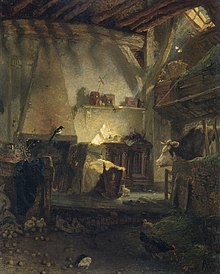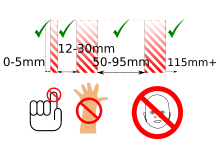
Sudden infant death syndrome (SIDS), sometimes known as cot death, is the sudden unexplained death of a child of less than one year of age. Diagnosis requires that the death remain unexplained even after a thorough autopsy and detailed death scene investigation. SIDS usually occurs during sleep. Typically death occurs between the hours of midnight and 9:00 a.m. There is usually no noise or evidence of struggle. SIDS remains the leading cause of infant mortality in Western countries, constituting half of all post-neonatal deaths.
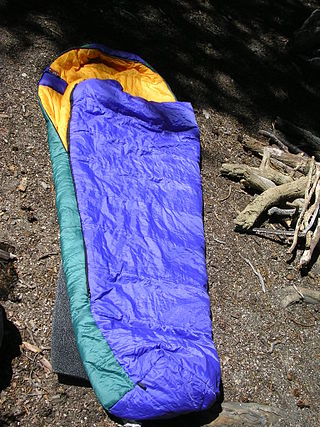
A sleeping bag is an insulated covering for a person, essentially a lightweight quilt that can be closed with a zipper or similar means to form a tube, which functions as lightweight, portable bedding in situations where a person is sleeping outdoors. It is also commonly used indoors for people who do not have beds or at sleepovers. Its primary purpose is to provide warmth and thermal insulation through its synthetic or down insulation. It also typically has a water-resistant or water-repellent cover that protects, to some extent, against wind chill and light precipitation, but a tent is usually used in addition to a sleeping bag, as it performs those functions better. The bottom surface also provides some cushioning, but a sleeping pad or camp cot is usually used in addition to that purpose. The bottom surface of a sleeping bag may be moderately water repellent, but a plastic tarp or groundsheet is often used to protect against moist ground.

An air mattress is an inflatable mattress or sleeping pad.
Co-sleeping or bed sharing is a practice in which babies and young children sleep close to one or both parents, as opposed to in a separate room. Co-sleeping individuals sleep in sensory proximity to one another, where the individual senses the presence of others. This sensory proximity can either be triggered by touch, smell, taste, or noise. Therefore, the individuals can be a few centimeters away or on the other side of the room and still have an effect on the other. It is standard practice in many parts of the world, and is practiced by a significant minority in countries where cribs are also used.

A bed is an item of furniture that is used as a place to sleep, rest, and relax.

Various methods of transport of children have been used in different cultures and times. These methods include baby carriages, infant car seats, portable bassinets (carrycots), strollers (pushchairs), slings, backpacks, baskets and bicycle carriers.
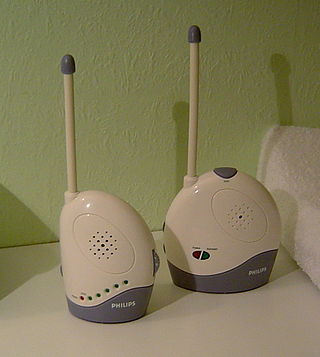
A baby monitor, also known as a baby alarm, is a radio system used to remotely listen to sounds made by an infant. An audio monitor consists of a transmitter unit, equipped with a microphone, placed near to the child. It transmits the sounds by radio waves to a receiver unit with a speaker carried by, or near to, the person caring for the infant. Some baby monitors provide two-way communication which allows the parent to speak back to the baby. Some allow music to be played to the child. A monitor with a video camera and receiver is often called a baby cam.

A bassinet, bassinette, or cradle is a bed specifically for babies from birth to about four months. Bassinets are generally designed to work with fixed legs or caster wheels, while cradles are generally designed to provide a rocking or gliding motion. Bassinets and cradles are distinguished from Moses baskets and carry cots, which are designed to be carried and sit directly on the floor or furniture. After four months, babies are often transferred to a crib or cot. In the United States, however, the bedside sleeper is the prevalent option, since they are generally bigger, recommended up to 6 months, and often used up to a year.
A toddler bed is a small bed designed for toddlers. A child grows capable of escaping an infant bed around one and a half or two years of age, at which they are often transitioned to a toddler bed. They become too large for a toddler bed between the ages of five and seven years, and will then transition to an ordinary bed.

The Safe to Sleep campaign, formerly known as the Back to Sleep campaign, is an initiative backed by the US National Institute of Child Health and Human Development (NICHD) at the US National Institutes of Health to encourage parents to have their infants sleep on their backs to reduce the risk of Sudden Infant Death Syndrome, or SIDS. The target age group of the campaign is 0–1 years of age, because this is when babies are at the greatest risk of experiencing SIDS. Since "Safe to Sleep" was launched in 1994, the incidence of SIDS has declined by more than 50%. However, there has been a rise in infant sleep-related suffocation events. Consequently, the campaign has broadened its goal to focus on safe sleep conditions and further preventative measures.

An orthopedic pillow is a pillow designed to correct body positioning in bed or while lying on any other surface. Its design conforms to orthopedic guidelines to ensure the right placement and support of one or more specific parts of the body to provide safe and healthy rest to the sleeper.

A travel cot is a bed for use by a baby or young child that collapses or folds into a bag for easy carriage. Travel cots are typically much lighter than a standard cot, with soft sides to provide comfort to the baby when sleeping.
Sleep training is a set of parental intervention techniques with the end goal of increasing nightly sleep in infants and young children, addressing “sleep concerns”, and decreasing nightime signalling. Although the diagnostic criteria for sleep issues in infants is rare and limited, sleep training is usually approached by parent(s) or caregivers self identifying supposed sleep issues.
Sudden unexplained death in childhood (SUDC) is the death of a child over the age of 12 months which remains unexplained after a thorough investigation and autopsy. There has not been enough research to identify risk factors, common characteristics, or prevention strategies for SUDC.

Baby furniture refers to furniture created for babies. It is often used to help the parents of the baby keep it safe and comfortable in the home. Before baby furniture, parents would sleep with their children in their own beds, which could be dangerous for the child. Eventually, infant beds started to be built with the child's safety in mind; the intention was to keep the baby from rolling off the bed, so mangers and bassinets were created. Over time, more furniture was created with the infant's safety in mind, and there are several types and functionalities of these. Typical pieces include an infant bed, changing table, high chair, playpen, baby walker, and toy chest. Products, features, and costs vary between countries and have changed over time. Safety is of paramount importance.

Infant clothing or baby clothing is clothing made for infants. Baby fashion is a social-cultural consumerist practice that encodes in children's fashion the representation of many social features and depicts a system characterized by differences in social class, richness, gender, or ethnicity.
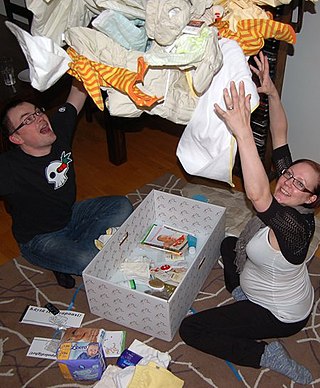
The maternity package, known internationally as the Finnish "baby box," is a kit granted by the Finnish social security institution Kela, to all expectant or adoptive parents who live in Finland or are covered by the Finnish social security system. The package contains children's clothes and other necessary items, such as nappies, bedding, cloth, gauze towels and child-care products. It was first issued in 1938 to parents with a low income, and contained a blanket, crib sheets, diapers, and fabric which parents could use to make clothing for the baby.

A bedside sleeper, also referred to as a sidecar sleeper or bedside bassinet, is a bassinet or baby cot that attaches to the parents' bed, allowing newborns to sleep next to their parents safely. This is a form of safe co-sleeping, and has little risks associated with sudden infant death syndrome, unlike bedsharing. Bedside sleepers are a component of rooming-in, a practice followed in hospitals to keep the baby by the mother's bed, giving her time to establish a stronger bond with her baby.
Infant and toddler safety are those actions and modifications put into place to keep babies and toddlers safe from accidental injury and death. Many accidents, injuries and deaths are preventable.
Newborn care and safety are activities and precautions recommended for new parents or caregivers. It is an educational goal of many hospitals and birthing centers to promote newborn care and safety as parents take their infant home.

